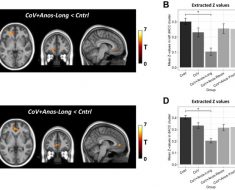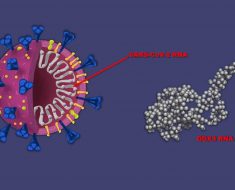‘Homing beacon’ that guides chemo drugs straight to the tumour ‘can kill cancerous cells while sparing healthy ones’
- Chemotherapy often destroys healthy cells, leading to nasty side effects
- Injecting a chemical nearby to the tumours ‘guided’ the drugs to the cancer cells
- When tested on mice, the chemical shrunk the tumours and lowered side effects
Scientists have created a ‘homing beacon’ that could guide chemotherapy drugs directly to a tumour.
The destruction of healthy cells, as well as cancerous ones, is the cause of common chemotherapy side effects, such as hair loss.
But a study has found a new gel injected near nearby to tumours could direct more of the potent drugs to the cancerous site.
When tested on cancer-ridden mice, the gel helped to shrink their tumours while easing chemotherapy’s side effects.

Scientists attached a dye to a gel that contained chemicals that target chemotherapy drugs. They injected the gel near the tumours of cancer-ridden mice. The gel ‘guided’ the drug to the cancerous cells, while sparing the animals’ healthy ones. The gel lingered in the rodents’ for 35 days (pictured), which would allow for repeated chemotherapy doses to be administered
The gel contains a compound that can be targeted by certain chemicals, which were attached onto the chemotherapy drugs.
The study was carried out by the University of Notre Dame in Indiana.
Destroying tumours while sparing healthy cells remains an ongoing challenge cancer treatment.
Chemotherapy targets rapidly growing cells. This includes those found in the roots of hair, which can result in baldness.
It also affects parts of the stomach and brain that detect toxic substances. This may trigger nausea and vomiting as the body tries to rid itself of the ‘poison’.
In the past, scientists have tried to guide chemo drugs to tumours by attaching antibodies that bind to proteins on the surface of cancer cells.
However, this resulted in less than one per cent of the drug reaching the tumour.
WHY CAN CHEMO FAIL TO WORK?
Cancer cells may figure out how to resist chemotherapy.
There are several reasons this may happen.
The cells that are not killed may mutate and change in response, repair the DNA damaged by the drug or develop a mechanism that renders it useless.
Therefore, the drugs’ success often relies on the failure of the cancer cell’s repairing mechanisms.
Cancer cells may produce hundreds of copies of a particular gene, known as gene amplification, triggering an overproduction of a protein which stops the effectiveness of treatment.
Cancer cells are sometimes able to push the drug out of itself, using a molecule called p-glycoprotein.
Because chemotherapy is the first line of treatment, it is a major concern when it fails to work.
Professor Workman chief executive of The Institute for Cancer Research, said: ‘Cancer’s ability to adapt, evolve and become drug resistant is the cause of the vast majority of deaths from the disease and the biggest challenge we face in overcoming it.’
The Notre Dame team of academics, led by Lei Zou, therefore tried a different approach using cucurbituril.
Cucurbituril is a hexagon-shaped synthetic receptor which can capture certain chemicals in its central cavity.
The team thought injecting the receptor and attaching chemicals it targets onto cancer drugs would guide more of it to the tumour.
The tumour’s acidic contents would rupture the link that holds the drug and the attached chemicals together, allowing the medication to be released.
To put their hypothesis to the test, the researchers first injected a hydrogel that contained cucurbituril beneath the skin of mice.
They then attached a dye to a chemical that targets cucurbituril to make it easily traceable.
This chemical was injected into the rodents’ bloodstreams, the researchers wrote in the journal ACS Central Science.
Results revealed 4.2 per cent of the injected dye was inside the hydrogel within a few hours, far better than any other approach.
In the second part of the experiment, the researchers injected the hydrogel next to the animals’ tumours.
They then treated the mice with the chemotherapy drug doxorubicin, which was attached to a targeting chemical.
These rodents experienced much slower tumour growth and fewer side effects than the animals that were just given doxorubicin.
And the hydrogel remained in the bodies of the mice for 45 days, according to the results of the study.
Source: Read Full Article





